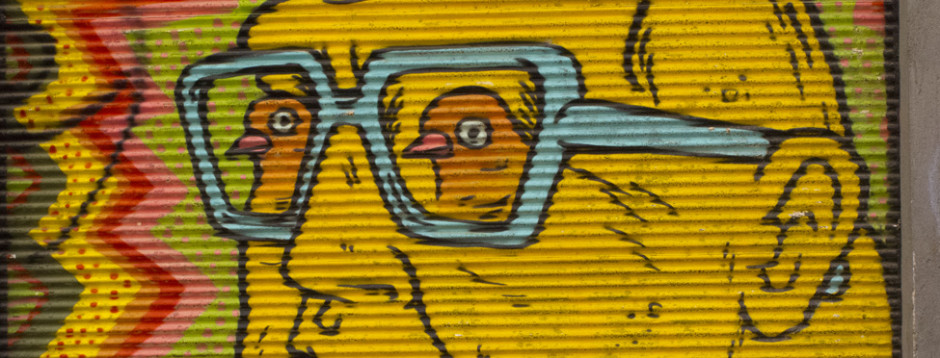In Hyperallergic-January 23, 2018
The Shekhawati region covers almost 5,000 square miles and hosts an estimated 2,000 frescoed buildings built from the 17th to the early 20th century.

A ceiling fresco in a haveli in India’s Shekhawati province (all photos by the author for Hyperallergic)
MANDAWA, India — Some artistic wonders have been unearthed as buried treasures. Others are hidden in plain sight. India’s Shekhawati province is in the northeastern Rajasthani desert and more than seven hours by car from Delhi. The region covers almost 5,000 square miles and hosts an estimated 2,000 frescoed buildings built from the 17th to the early 20th century. Many of them are abandoned and most are breathtakingly beautiful. Arguably the world’s largest collection of outdoor painting, Shekhawati is a treasure trove of startling architecture and adornment.

Driving through Indian agricultural towns, you can spy these buildings, called “havelis,” through the dust. Decorated with historic frescos, many are in a state of gentle but inexorable disintegration. The owners — almost all of the havelis are privately owned — have either abandoned the properties or rented them out to local people.
The Shekhawati region sits strategically in the middle of what was once the major trade caravan or “Silk Road” between modern-day India, Pakistan, China, and beyond. Over several centuries local merchants became rich in the trade and transport of opium, cotton, and spices. These communities became collectively known as “Marwari,” referring to the wily traders who brought commercial savvy and great wealth to the district. As a public show of their success, the Marwari commissioned ostentatious homes — the more elaborate the haveli, the richer and more prestigious its owner. As overland trade routes shifted to the seaports of Mumbai and Calcutta, the traders followed, moving their families, but maintaining and continuing to commission frescos for their Shekhawati havelis. Think of it as the Hamptons of Rajasthan.


Havelis were almost always built in the same basic form: two-storied with two to four inner courtyards, all in rectangular layout. Each courtyard and the rooms surrounding it were used for specific purposes; the first was always for men and their public business dealings. As one entered deeper, the rooms and courtyards became more intimate, used for various family purposes.

The frescos that adorn these buildings are a triumph of artistic expression and of the luck of climate, materials, and isolation. The dry heat of the desert and the use of 100% natural pigments in the plaster have proved surprisingly archival. The colors have remained rich and vibrant, although the interior exposures are much better preserved than the exteriors. The oldest of the frescos are painted using ochre, red and white lead, cinnabar, indigo, lapis, copper carbonate, Indian yellow (made from cow’s urine), lamp black, lime white, red stone powder, and saffron orange. The result is a vivid palate, augmented in some of the interior rooms by 22-karat-gold leafing. Later frescos incorporated synthetic pigments imported from Europe.

I visited the two main towns of the region, Mandawa and Nawalgarh, where there is a large concentration of havelis, but they are everywhere in the surrounding region. A few havelis have been preserved as small museums, where for a few rupees one can freely wander around the rooms and explore the labyrinth of courtyards, stairways, and balconies. The Haveli Heritage Trust in Nawalgarh is one of the best known and organized. Many havelis stand largely empty or barely used, but some are still inhabited.
In Mandawa I visited a haveli rented to a local family. After passing through a courtyard, I was ushered into the family bedroom. I looked up to find the entire room — walls and ceiling — painted with a mythological love story and gilded in 22-karat gold leaf. There was no electricity in the building, but the sunlight streaming through unglazed windows gave the room a brilliant glow.


For the most part the frescos tell glorious tales of the gods and goddesses of the Hindu pantheon. Mythological armies march across ceilings, goddesses perch on the walls, and elephants dance in the corners. Ganesha, the Hindu god associated closely with money and wealth, is honored many times over. Border motifs tend to use either decorative designs common to the era, or portray local flora and fauna, which give us a catalogue of the region’s natural history. Many display great playfulness, portraying the patron of the house and his family delighting in the interplay of two-dimensional painting and three-dimensional architecture.

In the more recent havelis (dating to the late 19th and early 20th centuries) we see the appearance of trains, hot-air balloons, and white people. The English colonizers make their appearance in the frescos as awkward figures. There is a sly political statement embedded in these funny, stiff depictions of the British, set against the elegance of the Indian gods and goddesses. The English are wearing way too much clothing for the heat of the Rajasthan desert; they stare with empty expressions at one another. One could argue that the painters were merely recording what they saw, but as one often finds in the art made under oppression, the painters and their patrons were likely proclaiming their views of the colonizers.

While remarkably intact for their age, these national treasures are being lost over time to neglect and reckless modernization. Local guides say there is an effort afoot to put this region on the UNESCO list of heritage sites, a complex and unlikely prospect given the havelis’ private ownership and their vast geographical span. (Hyperallergic reached out to UNESCO for comment, but received no response.) The Shekhawati frescos are off the well-worn Indian tourist path and difficult to get to, but you should see them if you can. They won’t last forever.


thanks for the upload
Thanks, Gunjan! 🙂
What breathtaking art!!
Thank you for taking the time to read and comment. Yes, the artwork is indeed breathtaking!